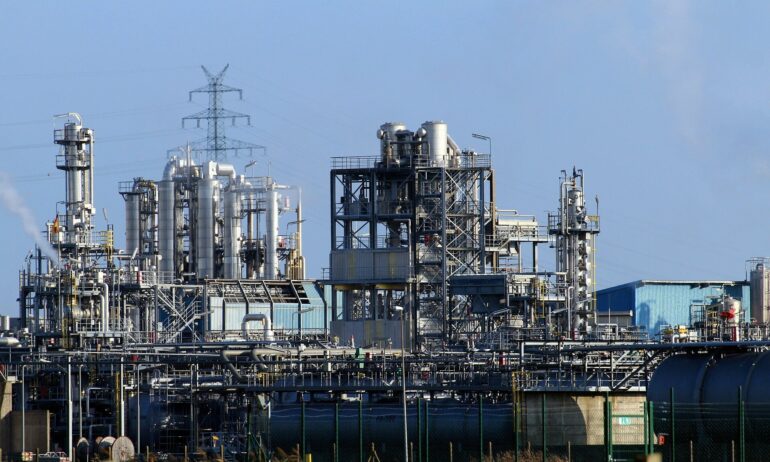A researcher with Sylvester Comprehensive Cancer Center at the University of Miami Miller School of Medicine and collaborators have penned a commentary highlighting how petrochemicals are a major contributor to cancer risks, resulting in a profoundly negative impact on overall health.
Their viewpoint article in JAMA Oncology explains how the pathway for petrochemical processing poses significant risks at every stage.
“There’s a petrochemical processing pathway,” said James Shultz, Ph.D., a Sylvester faculty member and associate professor in Miami’s Department of Public Health Sciences, and senior author of the article. “Fossil fuels are extracted, refined, processed, transported, used and ultimately disposed of, and each step along the way poses additional health risks.”
Shultz, co-author Jodi Sherman, MD, associate professor of anesthesiology and epidemiology at Yale School of Medicine, and lead author Leticia Nogueira, Ph.D., scientific director of health services research at the American Cancer Society (ACS), note that the petrochemical production infrastructure is densely interconnected, making human exposures considerably more commonplace.
They cited Louisiana’s “Cancer Alley,” a corridor along the Mississippi River, from Baton Rouge to New Orleans, Louisiana, with more than 200 petrochemical facilities—and cancer rates up to 50 times greater than the national average—as a prime example.
“Due to discriminatory policies and practices, hazardous petrochemical infrastructure, including drilling, fracking, extracting, refining and processing fossil fuels, is frequently sited in or near communities targeted for marginalization,” explained ACS’s Nogueira. “Communities like Cancer Alley where residents have experienced a long history of institutional and systemic racism resulting in lower socioeconomic status and limited political power.”
However, exposures are not limited to these areas because petrochemicals are constantly being transported via pipelines, trucks, trains and ships. “The transportation component puts virtually everyone in the U.S. at potential risk,” said Shultz.
Residents of East Palestine, Ohio, can attest to that reality after suffering from the aftermath of a freight-train derailment in February. The train was transporting vinyl chloride, a known carcinogen, and toxic smoke from a controlled release and burn of railway cars hovered over the community for days without dissipating, due to an atmospheric inversion.
East Palestine is neither a petrochemical center nor a marginalized community, but had the misfortune of being stuck amid an airborne toxic event. “Carcinogens may have seeped into the soil and aquifer, and residents could face higher future cancer risks,” explained Nogueira. “It reminds us that it’s hard to escape petrochemical risks.”
The authors noted that in addition to these harmful community exposures, petrochemical processing releases large amounts of greenhouse gases, contributing to the greatest current threat to human health—climate change. Every step of the process involves emission-intensive activities, releasing greenhouse gases and worsening climate change, with significant implications for cancer-control efforts.
“People living with cancer are already at elevated risk from the environmental hazards posed by climate disasters, including extreme heat, wildfires, hurricanes and floods,” said Nogueira. “More frequent and severe weather events increase the likelihood of patients being displaced from their homes and having their health care disrupted, with measurable consequences for patients relying on potentially lifesaving cancer care.”
Paradoxically, the U.S. health system is a major consumer of petrochemical products, mainly single-use plastics, and accounts for 8.5% of greenhouse gas emissions. “Health care uses a lot of disposable plastics and single-use materials, which escalated during the pandemic, so the petrochemical pathway often ends with us,” Shultz said. “We’re trying to save lives, but our recent shift toward single-use plastics in health care means oncology professionals end up contributing to the very problems they are working to solve.”
The authors are calling for the health care industry and its clinicians to be more aware of the potential ramifications for their practices and find ways to replace disposable and single-use items with reusables, whenever possible.
Doing so not only will reduce the health system’s environmental impact, but also make its supply chain more resilient during disasters and reduce community exposure to hazardous substances.
“Health care providers on the front lines are focused on saving lives,” Shultz said. “They’re probably not thinking about the connection between health care’s use of disposable plastics and corresponding impacts on climate change or community exposures to carcinogens.”
Fortunately, he added, there are current examples of ways to effectively diminish reliance on plastics and disposable products. “We need to adopt more of these practices.”
More information:
Leticia M. Nogueira et al, Derailing Carcinogens—Oncologists and the Ohio Train Derailment, JAMA Oncology (2023). DOI: 10.1001/jamaoncol.2023.4817
Provided by
University of Miami Leonard M. Miller School of Medicine
Citation:
Researchers explain how petrochemicals fuel cancer risks (2023, November 2)
